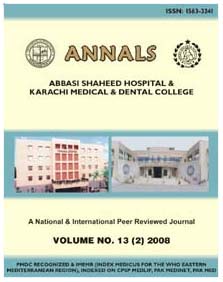
| |
| Home |
| Editorial Staff |
| Instruction to Authors |
| Journal-Issues |
| Policy |
| Newsletter |
| Copyright |
| DISPLACED SUPRACONDYLAR FRACTURES OF THE HUMERUS IN CHILDREN, TREATED BY CLOSED REDUCTION AND PERCUTANEOUS PIN FIXATION
REHANA ALI SHAH. ABSTRACT This prospective study was carried out at orthopedic unit of Abbasi Shaheed Hospital. The main objective of the study was to assess the role of closed reduction and percutaneous pin fixation in the management of displaced supracondylar fracture. From September 1993 to September 1995, 34 children with displaced supracondylar fractures, of humerus (Gartland type II and type III) were admitted through emergency and managed by closed reduction and percutaneous fin fixation, using two lateral K-wires. The average age of patients was 7.4 years, ranging from 2 to 12 years. Male to female ratio was 3.2:1. Left side was involved in majority of cases Majority of patients had extension type of fracture while flexion types were found in only two patient (5.9%). There were 13 children with Gartland type II fractures and 21 classified as Gartland type III. There was no associated head injury or abdominal injury. The patients had superficial soft tissue injuries around the elbow and two patients had open fractures. Neurological injuries were found in three patients with radial nerve involvement in two patients and median nerve in one patient. Average hospital stay was 3.6 days with minimum 2 days and maximum 6 days. Only those patients who had follow up of more than 5 months were included in the analysis of cosmetic and functional results. Thirty patients completed the follow up and 4 patients lost in the way. Functional results were evaluated from degree of loss of elbow movement and cosmetic results from change in carrying angle. These results were graded according to Flynn et al criteria. In 30 patients who completed the follow up, 95.4% showed excellent or good cosmetic results were recorded. Regarding the functional assessment, we had 81.8% excellent or good results 9% fair result and 9.1% poor results. Concluding in the last, closed reduction and percutaneous pinning of displaced, supracondylar fracture using two lateral pins, is safe, reliable, simplified and cost effective method of management.
|
For Full text contact to:
|
|
Associate Professor, Department of Orthopaedics, Karachi Medical & Dental College and Abbasi Shaheed Hospital, Karachi *
|

Copyright © 2009 Abbbas Shaheed Hospital and Karachi Medical & Dental College.
All rights reserved.
Designed & Developed by: Creative Designers